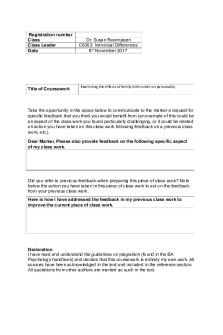individual behavior, personality and values PDF

| Title | individual behavior, personality and values |
|---|---|
| Author | Nur Hanysa |
| Course | Organizational Behaviour |
| Institution | Universiti Teknologi MARA |
| Pages | 2 |
| File Size | 181.2 KB |
| File Type | |
| Total Downloads | 155 |
| Total Views | 271 |
Summary
MARS Model Of Individual BehaviorMOTIVATION : Effect a person’s voluntary choice of behavior (Direction, Intensity, Persistence)ABILITY : Require to complete a task : Job matching (Selecting, Developing, Redesigning)PERCEPTIONS : Understand job duties : Clear when we understand task consequences/pri...
Description
MARS Model Of Individual Behavior
MOTIVATION : Effect a person’s voluntary choice of behavior (Direction, Intensity, Persistence) ABILITY : Require to complete a task : Job matching (Selecting, Developing, Redesigning)
PERCEPTIONS : Understand job duties : Clear when we understand task consequences/priorities : Understand preferred behavior/procedured Benefit: more accurate job performance, high motivation, better coordination with others
TYPES OF INDIVIDUAL BEHAVIOR Task Performance • Goal-directed behaviors under the individual’s control that support organizational objectives • Working with people, data, things, and ideas • Performance includes proficiency, adaptability, and proactivity Organizational Citizenship • Cooperation and helpfulness to others that support the organization’s social and psychological context • Directed toward individuals and organization • Not necessarily discretionary (part of employment obligations)
DEFINING PERSONALITY Relatively emotions, and behaviors that characterize a person, along with the psychological processes behind those characteristics External traits and internal states Personality traits Clusters of internally-caused behavior tendencies Traits apparent across situations, but situation may suppress behavior tendencies
SITUATIONAL FACTORS : Envinronmental conditions beyond the individual’s short-term control that constrain/facilitate behavior. Constraints: time, budget, facilities Cues: signs of nearby hazards
TYPES OF INDIVIDUAL BEHAVIOR Counterproductive work behaviors • Voluntary behaviors that have the potential to directly or indirectly harm the organization Joining & staying with the organization • Forming the employment relationship and staying with the organization Maintaining work attendance • Absences due to situation (weather), motivation (avoid- stressful workplace) • Presenteeism – attending scheduled work when one’s capacity to perform is significantly diminished by illness or other factors
NATURE V NURTURE OF PERSONALITY Influenced by nature Heredity explains about 50 percent of behavioral tendencies and 30 percent of temperament Minnesota studies – twins had similar personalities Influenced by nurture: Socialization, learning Personality stabilizes in young adulthood Executive function steers behavior guided by our self-concept
VALUES IN THE WORKPLACE
FIVE FACTOR PERSONALITY MODEL (CANOE) • • • • •
Conscientiousness Agreeableness Neuroticism Openness to experience Extraversion
Organized, dependable trusting, helpful, flexible, anxious, selfconscious, creative, energetic, talkative
•
• •
Stable, evaluative beliefs that guide our preferences o Define right/wrong, good/bad – what we will do situation o Direct our motivation, potentially decisions and behavior Value system -- hierarchy of values Compared with personality, values are: o Evaluative (not descriptive) o May conflict strongly with each other o Affected more by nurture than nature
SCHWARTZ’S VALUES MODEL
• • • • • • • •
Openness to change – motivation to pursue innovative ways Conservation -- motivation to preserve the status quo Self-enhancement -- motivated by self-interest Self-transcendence -- motivation to promote welfare of others and nature Values motivate – guide decisions, behavior, and performance But also “disconnect” between values and behavior because: Situation -- interferes with values-consistent behavior Awareness (salience) -- values are abstract -- relevance isn’t obvious
•
•
To increase values-consistent behavior: o Keep work environment values-consistent (rewards) o Remind employees of important values o Improve sensitivity to relevance of values Similarity of a person’s values hierarchy to another source o Person-organization values congruence o Espoused-enacted values congruence o Organization-community values congruence...
Similar Free PDFs
Popular Institutions
- Tinajero National High School - Annex
- Politeknik Caltex Riau
- Yokohama City University
- SGT University
- University of Al-Qadisiyah
- Divine Word College of Vigan
- Techniek College Rotterdam
- Universidade de Santiago
- Universiti Teknologi MARA Cawangan Johor Kampus Pasir Gudang
- Poltekkes Kemenkes Yogyakarta
- Baguio City National High School
- Colegio san marcos
- preparatoria uno
- Centro de Bachillerato Tecnológico Industrial y de Servicios No. 107
- Dalian Maritime University
- Quang Trung Secondary School
- Colegio Tecnológico en Informática
- Corporación Regional de Educación Superior
- Grupo CEDVA
- Dar Al Uloom University
- Centro de Estudios Preuniversitarios de la Universidad Nacional de Ingeniería
- 上智大学
- Aakash International School, Nuna Majara
- San Felipe Neri Catholic School
- Kang Chiao International School - New Taipei City
- Misamis Occidental National High School
- Institución Educativa Escuela Normal Juan Ladrilleros
- Kolehiyo ng Pantukan
- Batanes State College
- Instituto Continental
- Sekolah Menengah Kejuruan Kesehatan Kaltara (Tarakan)
- Colegio de La Inmaculada Concepcion - Cebu















